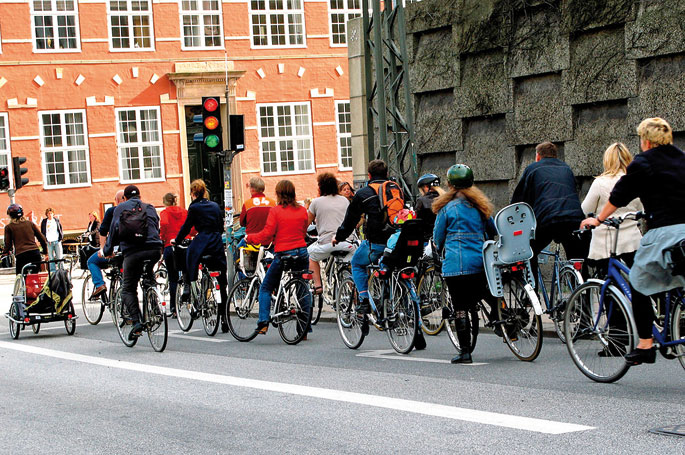
- “The goal of the car industry, insurers and government officials is that people who ride bicycles inside the city are forced to wear and tighten traffic rules,” says American blogger Eben Weiss. “Cyclists want to avoid liability for any damage they may suffer, as well as the lack of adaptation of infrastructure.”

“They’re just looking to criminalize the weakest, not having to build better infrastructures for pedestrians and cyclists, the same rights and obligations for everyone with the trap argument,” Weiss said on the Bike Snob blog in Washington Post, New York. It has in its sights US legislation, but what is said in the text serves to explain other realities. It says that the obligation of cyclists to wear a helmet, reflective clothing and all kinds of gleaming gadgets is a distraction to maintain the hegemony of cars. “Don’t make cyclists more showy, get them not to get their cars caught,” he asked the authorities.
Although he recognizes that things are changing little by little, the blogger continues to point to the victim, whether they are pedestrians or cyclists. “When cars took over cities, some demanded stricter traffic rules. The car industry began a propaganda war with the guise of the security campaign. One of the greatest successes has been the figure of the pedestrian and the reckless cyclist, who robbed us of the right to movement”:
We have also read that the idea of American equality has prevailed in the mobility processes: “In reality it is an evil concept that justifies inequalities because it puts the most powerful and the weakest on the same level.” He says it's not the same to ride in an 800-kilogram car as to ride a bicycle between cars that keep accelerating with their 80-kilograms. “I’m not saying there shouldn’t be a car, I have one,” Weiss says. “The point is that cars are like white people on Wall Street, they don’t need anyone to offer them more protection.”
Forcing to wear the helmet repels cyclists
In the words of the blogger, the regulations of the helmet allow citizens to avoid the use of bicycles in everyday life (to go to work, to go shopping...), on the one hand because it can be uncomfortable and on the other because it makes us believe that it is more dangerous not to dress than it seems.
Those of us who regularly follow professional cycling races on Spanish television have often heard these kinds of statements from former cyclist Pedro Delgado. In their opinion, everyone should decide whether to put the helmet in the cities, taking into account that “if a car is hit, it serves little”. According to the SIBUS agency of the University of Seville, based on data from the traffic direction DGT, the number of cyclists who have suffered a serious mental injury – less and less, because cities are safer – shows little difference between those who wear a helmet and those who do not. Delgado says that the need to wear a helmet reduces bicycle journeys, as shown by data from Australia and New Zealand: since the entry into force of the law governing the use of a helmet, the number of people travelling by bicycle has decreased by between 20 and 40%.
In this regard, the coordinator ConBici, in defence of the bicycle, has warned that the use of the helmet by adults is not mandatory in any European country. In Denmark and the Netherlands, to mention two countries, bicycles are used by a multitude of people who, in addition to being protected by regulations, are more aware of motorists.
In the words of Delgado, the mandatory use of the urban area demonstrates that we are subject to the rules of the game of the insurers: “A cyclist with a helmet hit by the car has one price and the one who doesn’t wear a helmet has another. In the second case, car insurance may be exempted from compensation; it is unfortunate.”
In Hegoalde, compulsory for children under 16
In the case of Hego Euskal Herria, two groups must be distinguished: Under 16 years of age and over. It is always an urban traffic; in all the interurban roads it is necessary to wear a helmet.
In March last year, the Spanish Traffic Act made it compulsory to wear a helmet for children under 16 years of age. Although pp wanted to force all people, regardless of their age, to use a helmet on internal displacement, opposition groups rejected the measure and the popular finally decided to reverse it. In the event of non-compliance, young people must pay a fine of EUR 200.” In the North, on the contrary, there is no obligation to wear a helmet anywhere.
There is no doubt that the issue should be considered and discussed at length if we are to promote an effective urban policy.
Galdera hori luzatu dio hainbat eragileri Fredrik Gertten suediarrak, Bikes vs cars (Bizikletak vs autoak) dokumental estreinatu berrian. Brasilgo ekintzaileek boteprontoan erantzun dute: petrolio konpainiek eta automobil industriak. Eta Europan ere, antzera. Esaterako, Alemanian, Angela Merkel kantzilerrak autoen emisioen aurkako legeak gogortzeari betoa jarri zion unean, BMW konpainiak CDU alderdiaren kanpaina 690.000 eurorekin lagundu zuela jakinarazi zuten hedabideek.
Gaur egungo egoera zertan den azaltze aldera, denboran atzera egin du dokumentalak, hiri batzuen transformazioa nabarmentzekoa baita oso. Los Angeles (AEB) dugu erakusgarri. XX. mendean munduko garraio publiko sare onenetakoa zuen; gaur egun, ordea, bere lurzoruaren %75 errepideek hartzen dute. Zergatik gertatu da hori? General Motors konpainiak kontrolatzen duen enpresa batek hiri-autobusa erosi zuen, eta zerbitzua murriztu egin du apurka-apurka, errepide gero eta gehiago eraikitzen zuen bitartean. Halaber, tranbia zerbitzua ere desmantelatu dute. Azken urteotan Los Angeleseko biztanle kopurua %20 hazi da, eta autoena %230. Toronton (Kanada), automobil industriak hauspoturik, alkateak murriztu egin ditu kotxeentzako matrikulazio zergak... baita bidegorri kopurua ere. Ondorioa: autoen eta bizikleten arteko istripuek gora egin dute.